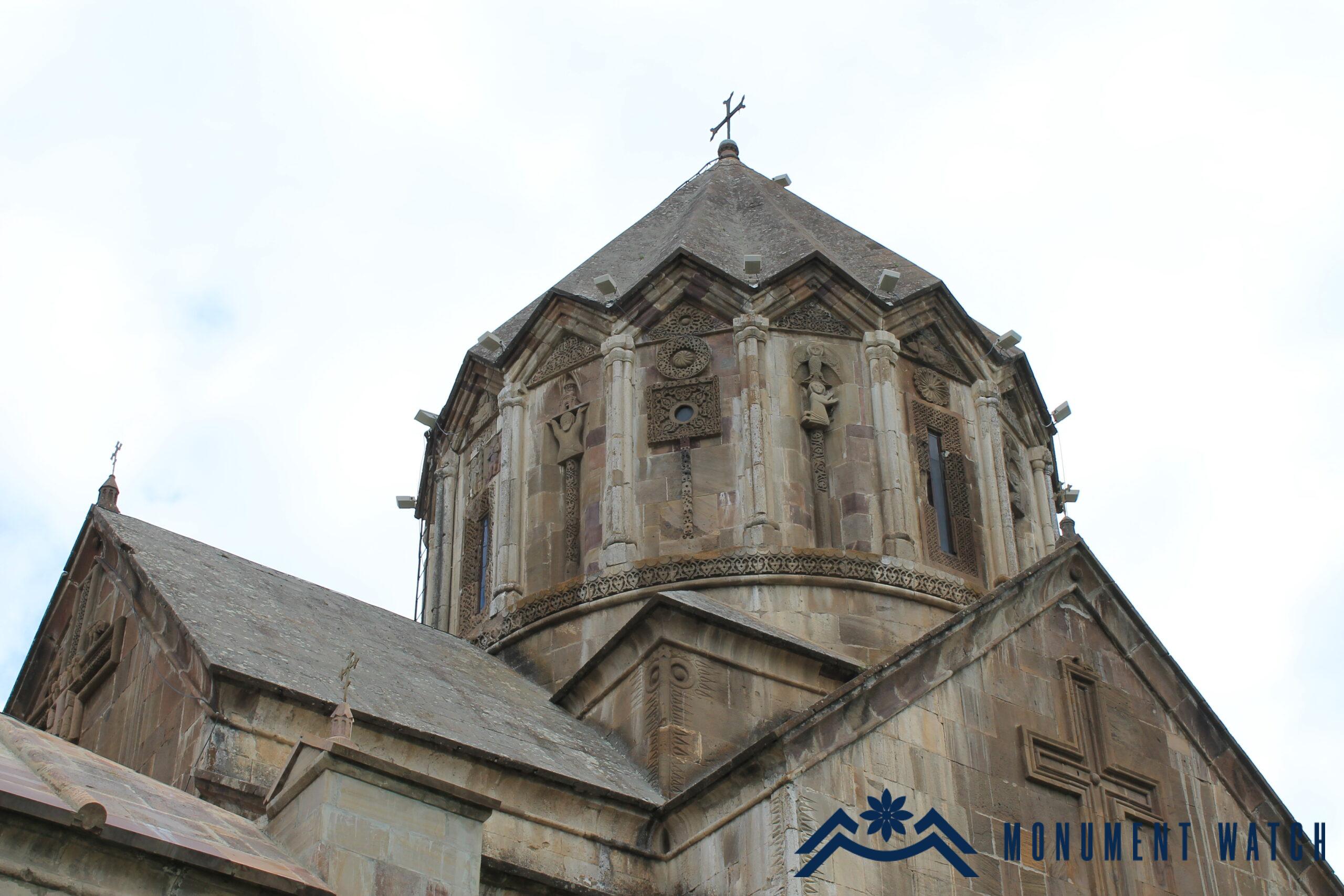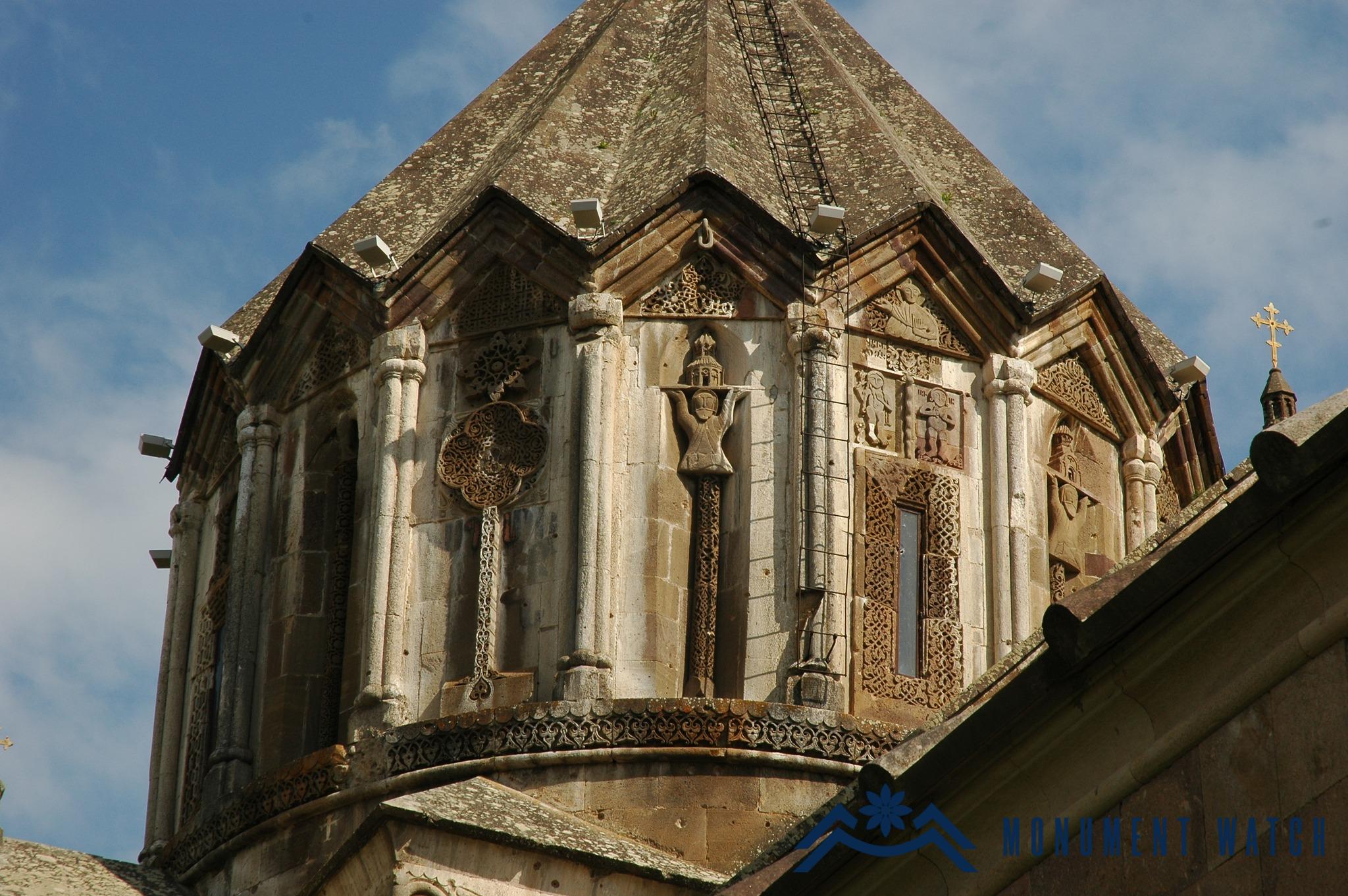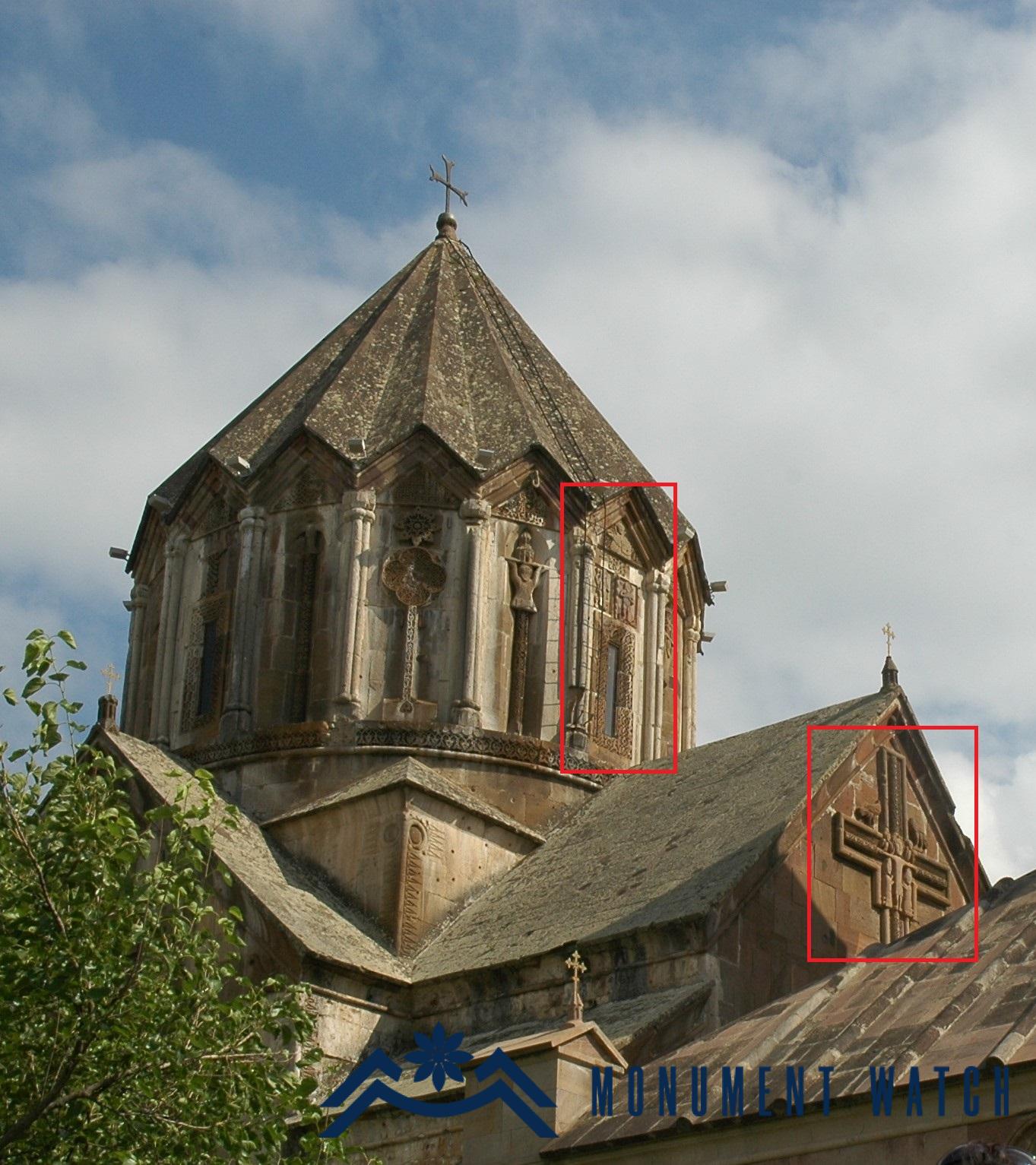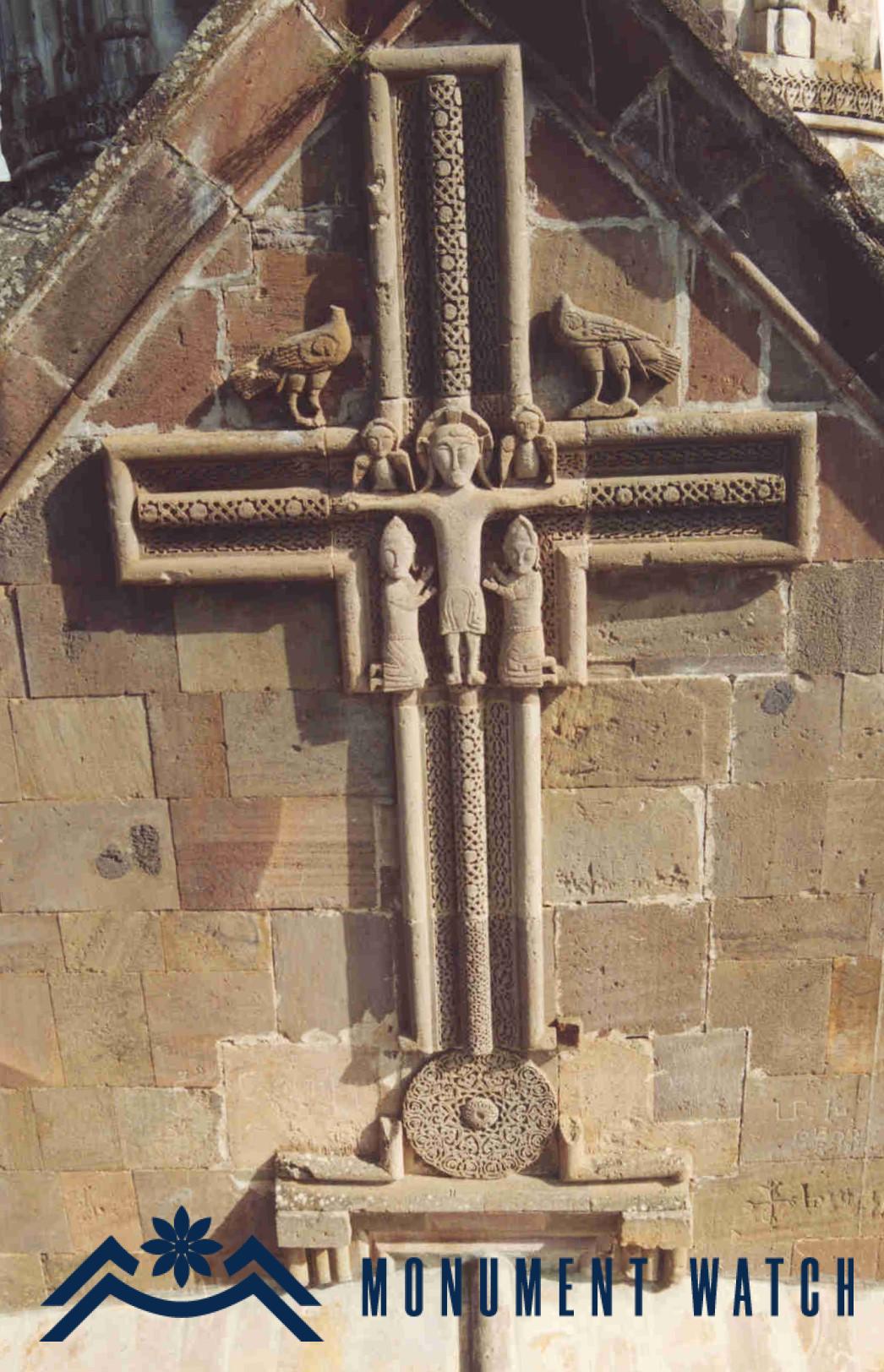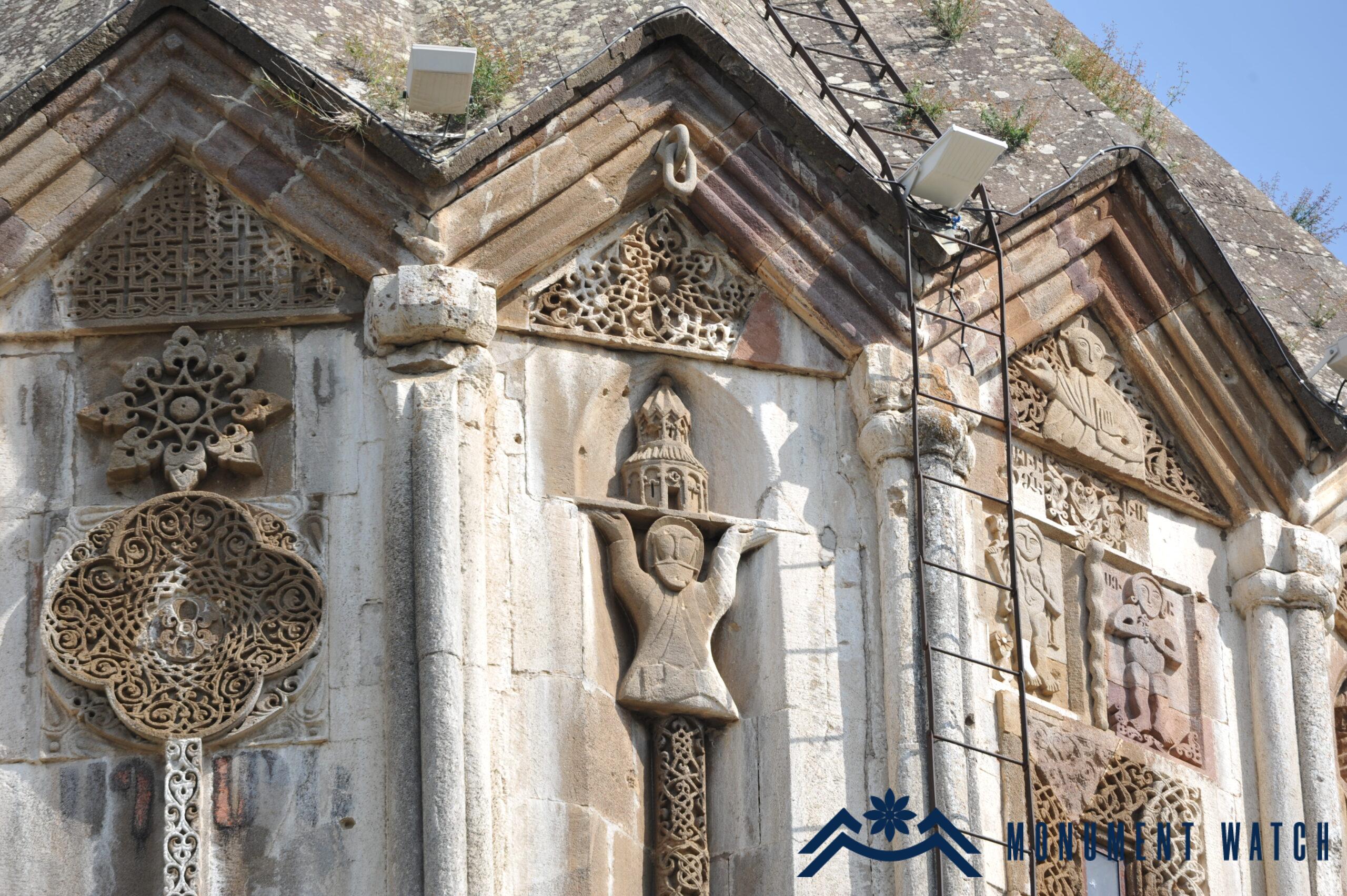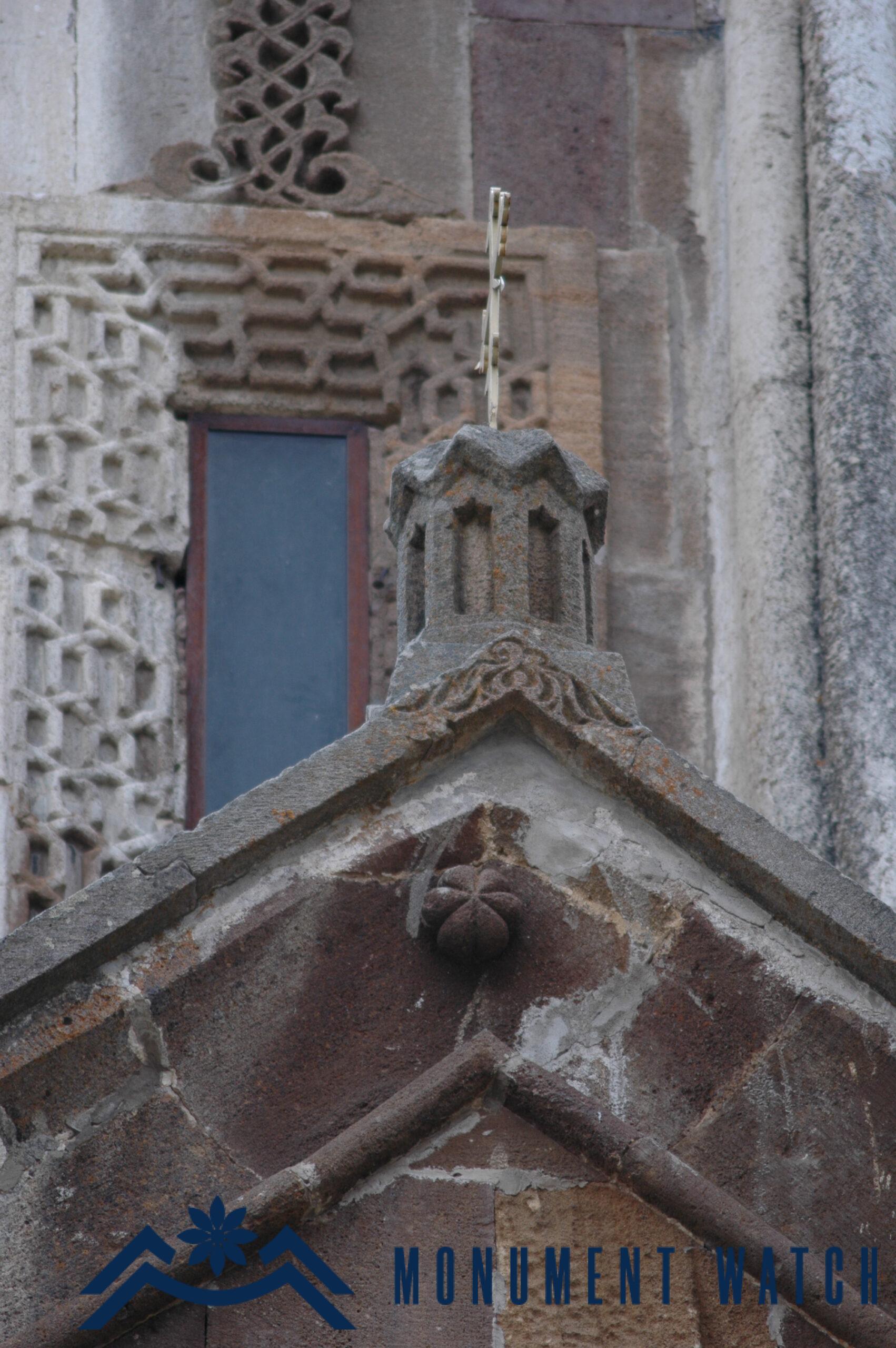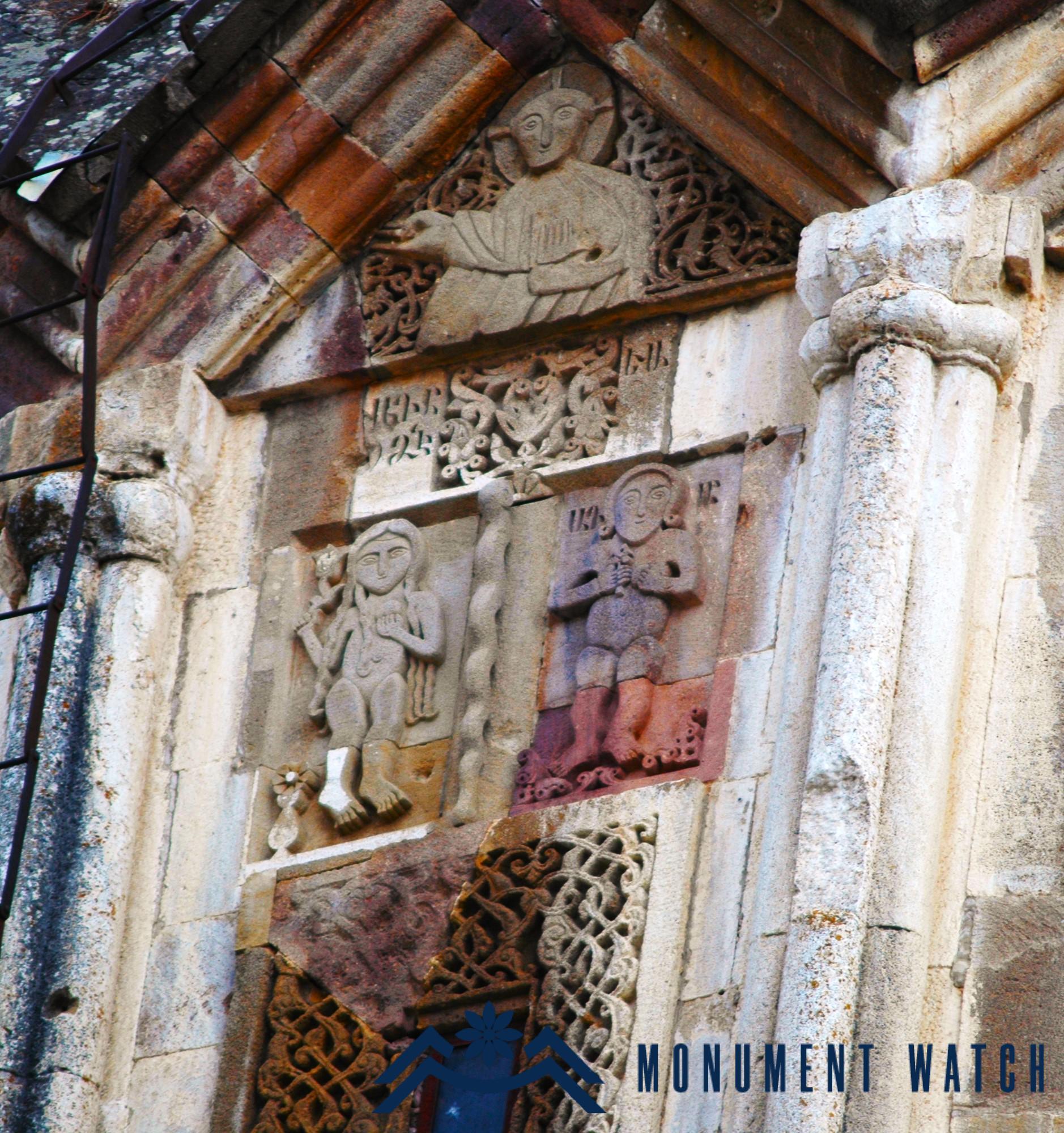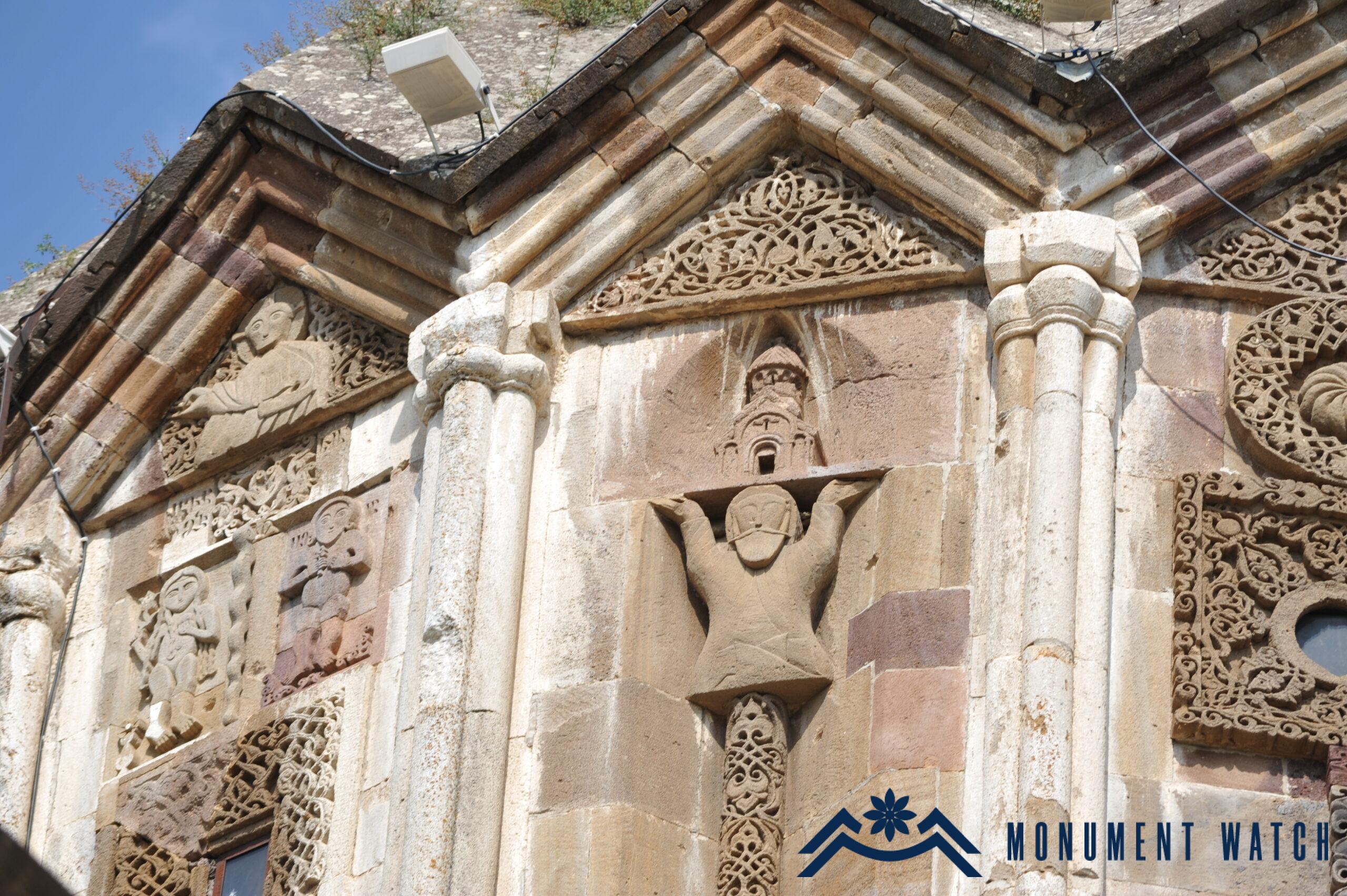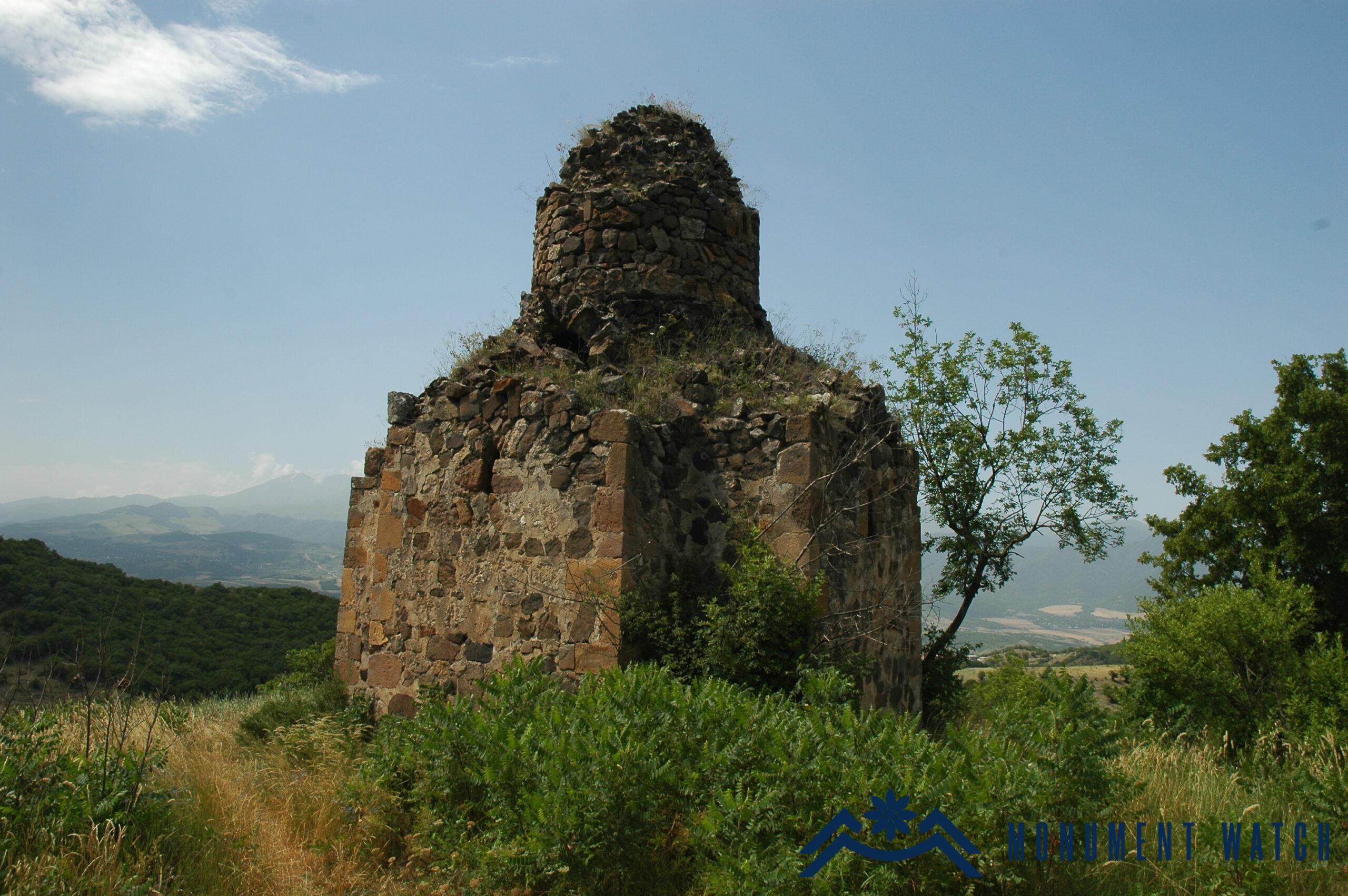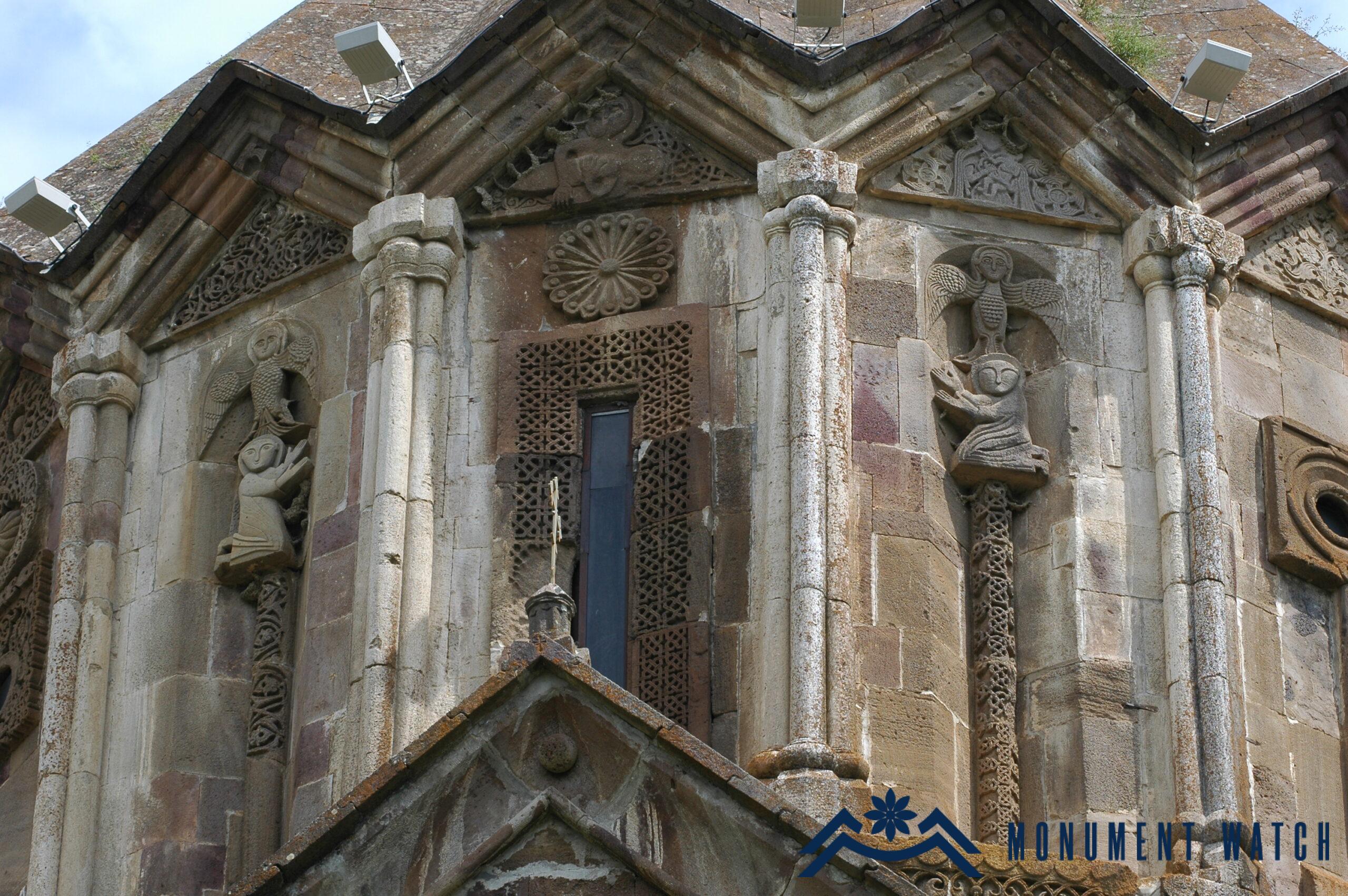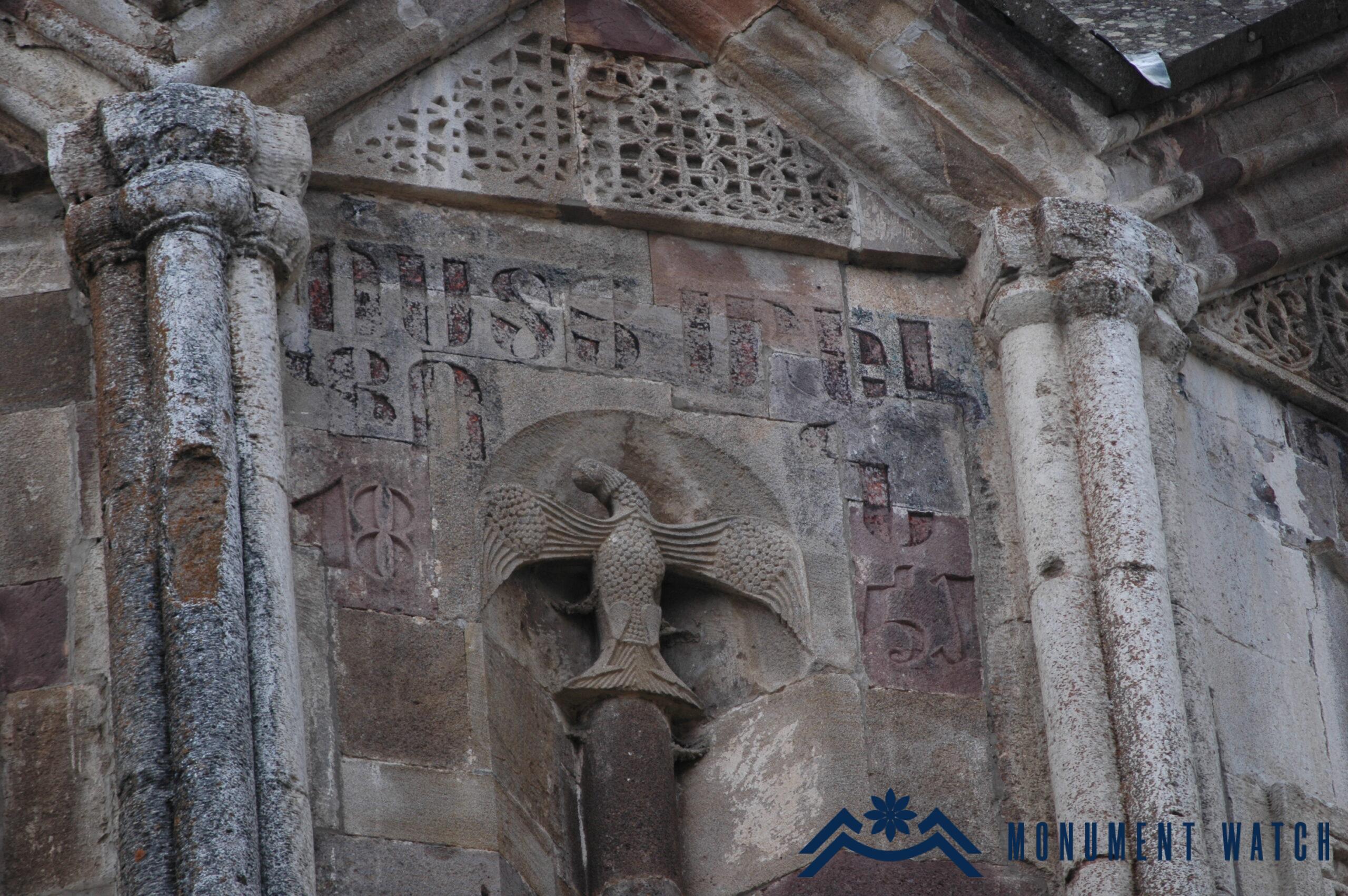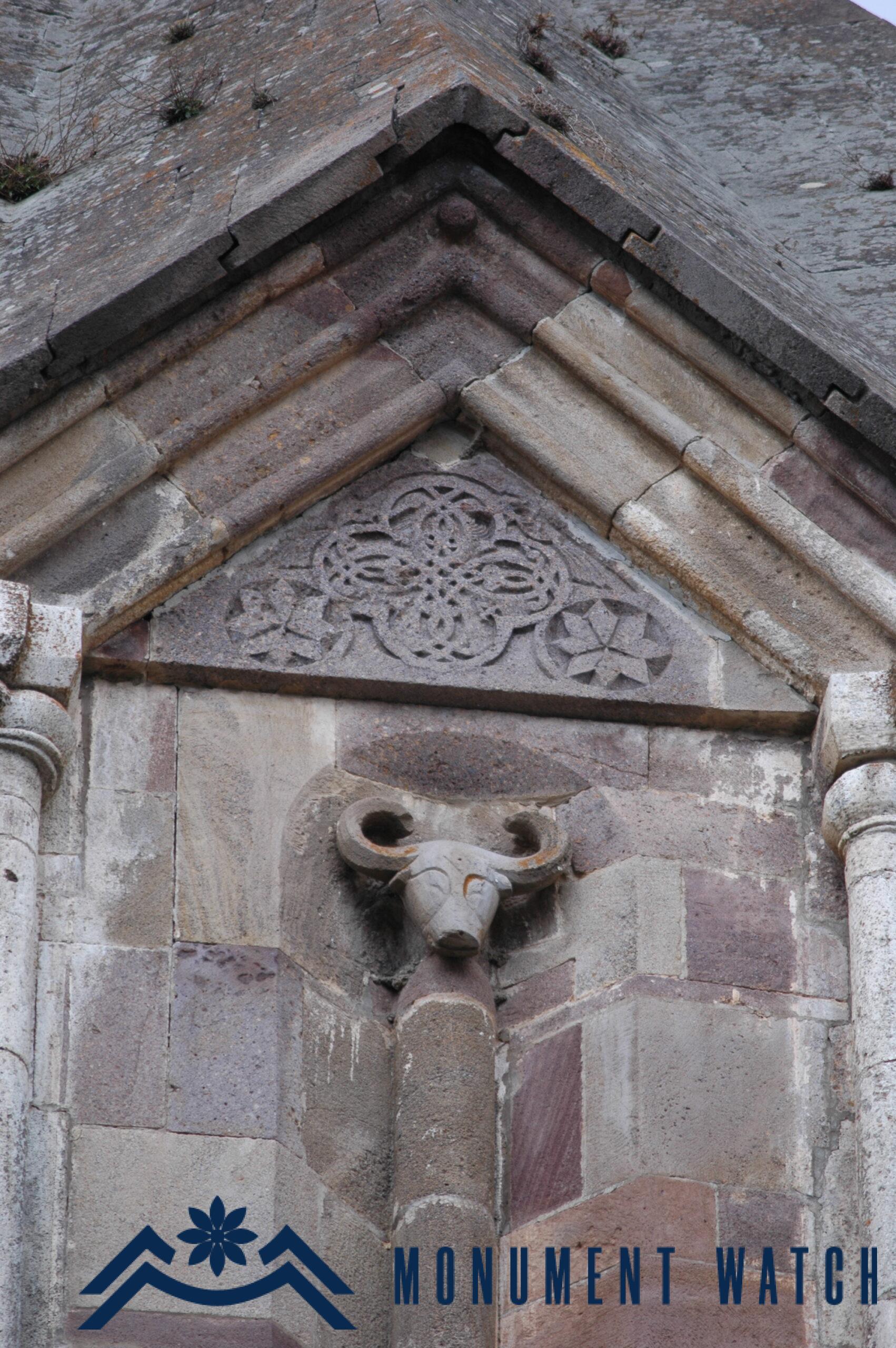The dome and sculptural compositions of the Surb Hovhannes Mkrtich Church of Gandzasar
The dome of the Surb Hovhannes Mkrtich Church of Gandzasar, with its sculptural iconographic system and artistic style, holds a unique place in the history of medieval Armenian architecture and art (Fig. 1). The fan-shaped dome of the Surb Hovhannes Mkrtich Church of Gandzasar is supported by a polyhedral drum, featuring 16 sections that terminate with small pediments. The sides of the drum are adorned with clusters of tall semi-columns, culminating in intricately sculpted capitals (Fig. 2).
The external alcoves with a triangular design, in the depth of which are semi-columns bearing diverse sculptures and frequently exquisitely sculpted, lighten the solid mass of the wall of eight of the facets.
The remaining facets are flat, and four of them open the drum's tall, thin windows. The latter are enclosed in rectangular frames that have beautiful embellishments on them. Above the windows are rosettes or thematic bas-reliefs.
The remaining four facets feature round windows, which are opened and adorned with intricately carved frames consisting of wide and deep ribs. These windows can be found on the southeast and southwest sides.
One of the facets stands out as it is solely ornamented with a lavish lace rosette, lacking a window.
The sculptures within the dome drum hold significant symbolic meaning, and they are meticulously arranged in a specific order within the sessions. These sculptures depict Christian iconography associated with the princely house of Khachen. Their arrangement appears to convey a summarization of devotion to the entirety of Christian history, the fulfillment of divine commandments, the reverence for parental behest, and the fear of God. The iconographic series begins from the western front, encompassing not only the composition of the drum session but also incorporating the unique composition of the crucifixion on the west facade (Fig. 3).
Before the addition of the gavit, the western facade of the church was fully visible and showcased three vertically arranged compositions: the Crucifixion (Fig. 4), the Paccancy, and the Righteous Judgment (Fig. 5). These compositions appeared to serve as a concise representation of the divine interventions and blessings bestowed upon the Khachen princely house in the highlands. On the facets to the right and left of this central axis, two men with the same face, a beech beard, and the same clothes and overall similar appearance, are cross-seated, each holding a miniature of the church above their heads (Figs. 2, 6, 7).
According to researchers, these sculptures represent Hasan Jalal Dola and his son Atabak, who commissioned the construction of the church (Yakobson 1977, 67). However, it should be noted that Atabak is not mentioned in the historical records pertaining to the church's construction. Instead, the inscriptions specifically mention Hasan's father, Vakhtang, and his commandment to build a church. "I, Jalal Dola Hasan, a humble servant of God, the son of Vakhtang... Before my father passed away, he entrusted me and my mother Khorishah, the daughter of Sargis the Great, a respected prince, with the task of constructing a church and establishing a cemetery for our ancestors in Gandzasar... "(cf. CAE 5, 38; cf. Ulubabyan 1981, 87–88). It is highly likely that these are indeed the sculptures of Vakhtang and Hasan as patrons of the church. Furthermore, following the father-son sequence, it is probable that the figure on the left represents Vakhtang (see Fig. 6), while the figure on the right represents Hasan (see Fig. 7). This interpretation is supported by the fact that the miniature held by Hasan bears a striking resemblance to the westward view of the Gandzasar church. Additionally, the replica associated with Vakhtang corresponds to the only remaining contemporary domed church in the region of Inner Khachen, namely the Surb Astsvatsatsin Church of Poghosagomer (see Fig. 8). The church's inscription confirms that it was erected during Vakhtang's reign (CAE 5, 91).
The models of the drum of the Gandzasar Church, along with the sculptures of the builders, belong to the category of donative art that can be found in various Armenian monasteries, including Aghtamar, Haghpat, Sanahin, Harichavank, Haghartsin, and others. Additionally, within the Gandzasar Church, there is a miniature that serves as a pediment decoration. The tops of all four pediments of the structure are adorned with distinct miniatures showcasing small domes (Fig. 9). Such decorative ornaments on the pediments are also commonly found in other architectural complexes of the time, including Harichavank, Abdrazakash St. Grigor, Geghard, and others.
Proceeding from the western side to the southern side, the iconographic sequence of the dome unfolds with sculptures portraying kneeling women engaged in prayerful gestures (Fig. 10). Flanking these figures are depictions of the Virgin Mary and the child, while above their heads, a representation of "hooshkapariks, mythical spirits associated with the belief that they dwelled within ruins" can be observed. Considering the contextual logic of the church building inscription, it is highly probable that the depicted figure here represents Khorishah, Hasan's mother and his wife Mamkan. "Before my father passed away, he entrusted me and my mother Khorishah, the daughter of Sargis the Great, a respected prince, with the task of constructing a church and establishing a cemetery for our ancestors in Gandzasar. The construction of the church commenced in the year 765 of the Armenian Calendar (1216) with the divine assistance of the Benefactor (God). After we completed the construction of the wall above the windows, my mother decided to renounce worldly life and embarked on her third pilgrimage to Jerusalem. She embraced a life of devotion, wearing a cilice and dedicating many years in seclusion near the Temple of the Lord. On the day of the Holy Resurrection of Christ, she peacefully passed away and was laid to rest there" (cf. CAE 5, 38, cf. Ulubabyan 1981, 87-88). In the iconographic series, the subsequent sculptures portray animals, including a bull, an eagle, and a ram (Figs. 11, 12). Notably, the first two animal sculptures are intertwined with the composition of the crucifixion. These animal representations symbolize the military prowess of Khachen rule and its rulers.
The sculptures adorning the dome of Surb Hovhannes Mkrtich Church are not only remarkable in terms of architectural ornamentation but also hold profound meaning. Anatoly Yakobson was the first scholar to delve into their semantic interpretation. He notably criticized the misleading and unscientific publications of Azerbaijani "experts" regarding these sculptures (Yakobson 1977, 75, 76).
The iconographic series of the Gandzasar dome represented a significant innovation that embodied the essence of its time when the political-liberational component was included alongside the solely religious-ecclesiastical one, fusing the religious with political accomplishments.
Bibliography
- CAE 5 - Corpus of Armenian Epigraphy, issue 5, Artsakh/ made by S. Barkhudaryan, Publishing House of the USSR Academy of Sciences of RA, Yerevan, 1982.
- Ulubabyan 1981 - Ulubabyan B., Gandzasar, "Armenia" publishing house, Yerevan.
- Yakobson 1977 - Yakobson A., from the history of Armenian medieval architecture. Bulletin of Social Sciences, No. 12․
The dome and sculptural compositions of the Serb Johannes Mkrtich Church of Gandzasar
Artsakh

